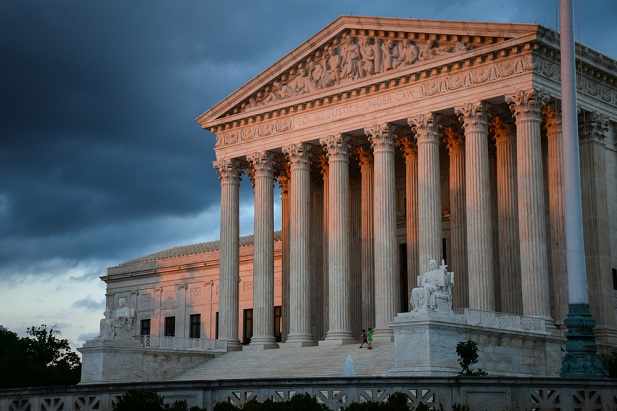 The circuit split lets plaintiffs simply claim they never read plan documents, and without input from SCOTUS, plaintiffs' attorneys will be encouraged to forum-shop claims within the Ninth Circuit, Intel says. (Photo: Shutterstock)
The circuit split lets plaintiffs simply claim they never read plan documents, and without input from SCOTUS, plaintiffs' attorneys will be encouraged to forum-shop claims within the Ninth Circuit, Intel says. (Photo: Shutterstock)
Fiduciaries to Intel Corp.'s defined contribution plans have petitioned the Supreme Court to clarify the Employee Retirement Income Security Act's statute of limitations.
Intel's petition arises from a claim first brought in 2015 in the U.S. District Court for the Northern District of California. A former Intel employee alleged fiduciaries to two defined contribution plans sponsored by the firm breached ERISA by loading a target-date fund with large allocations to hedge funds and private equity investments.
The case gained notice for Intel's aggressive use of alternative investments at a time when more sponsors were populating investment menus with passively managed investments in response to a growing body of excessive fee claims against 401(k) plans.
But the prudence of using alternative investments to hedge long-term risk and volatility in a retirement plan was never addressed by the district court.
Instead, a magistrate judge ruled in 2017 that the claim was time-barred under ERISA's statute of limitations, and issued a summary judgment in favor of Intel to dismiss the case.
Ninth Circuit defines 'actual knowledge'
ERISA's statute of limitations includes a provision saying claims against plan fiduciaries must be brought within three years of the earliest date a plaintiff had "actual knowledge" of a breach.
The plaintiff, who worked for Intel between 2010 and 2012, received notifications of plan documents housed on dedicated websites for plan participants. A "Fund Fact Sheet," posted in 2010, disclosed that Intel's alternative-centric strategy was underperforming index funds as equity markets recovered from the Great Recession.
Court documents reveal that the plaintiff visited the web pages outside of the three-year statute of limitation. But in depositions he testified that he did not recall reading the relevant information.
In November of 2018, the Ninth Circuit Court of Appeals unanimously overturned the lower court's ruling in favor of Intel.
At issue was the definition of "actual knowledge" in ERISA's text. The Ninth Circuit defined the phrase to mean "what it says," according to its ruling.
"We hold that the phrase 'actual knowledge' means the plaintiff is actually aware of the facts constituting the breach, not merely that those facts were available to the plaintiff," the Ninth Circuit said.
The appellate court acknowledged Intel's evidence that the plaintiff had sufficient information at his disposal to base allegations before the three years preceding his claim.
"However, that is insufficient," the court said. "If (the plaintiff) in fact never looked at the documents Intel provided, he cannot have had 'actual knowledge of the breach' because he cannot have been aware that imprudent investments were made and that other Intel fiduciaries were failing to monitor or remedy that imprudence."
Courts struggle to apply ERISA's statute of limitations
The Ninth Circuit's decision creates a split with the Sixth Circuit.
In a 2010 decision in favor of Owens Corning's retirement plan, the Sixth Circuit said, "when a plan participant is given specific instructions on how to access plan documents, their failure to read the documents will not shield them from having actual knowledge of the documents' terms."
Courts across the country have struggled in applying ERISA's statute of limitations, write Chris Scheithauer and Rick Pearl, ERISA litigators with McDermott, Will and Emery.
The Ninth Circuit's interpretation of actual knowledge is "practically problematic," the attorneys wrote in a blog post.
"A defendant will have to prove that a plaintiff in fact read materials in order to show a plaintiff had knowledge of facts contained in those materials. In our experience, plaintiffs in ERISA cases do not always read information about their accounts and plans, despite repeated and fulsome attempts by the plans to educate participants. Plan fiduciaries should consider requiring participants to acknowledge receipt and review of materials to help avoid a factual dispute," write the attorneys.
In its petition to the Supreme Court, attorneys for Intel argue the Ninth Circuit's decision will render ERISA's three-year limitation meaningless.
"The Ninth Circuit's constricted reading of 'actual knowledge' will undermine the balance that ERISA's carefully crafted disclosure framework seeks to achieve," according to Intel's petition.
"Under that reading, no amount of disclosure by plan fiduciaries can ensure that plan participants will possess actual knowledge of the facts disclosed by the plan, enabling virtually every plaintiff to get past a motion for summary judgment. Indeed, plan participants will be discouraged from timely reviewing the disclosures provided by the plan, knowing that doing so will insulate them from a limitations defense—precisely the opposite of what ERISA's robust and reticulated disclosure regime is designed to accomplish," Intel's position says.
The circuit split also exposes multistate employers to different interpretations of ERISA, and gives plaintiffs a roadmap for avoiding the statute of limitations by simply claiming they never read plan documents, argues Intel.
Without input from the Supreme Court, plaintiffs' attorneys will be encouraged to forum-shop claims within the Ninth Circuit, say Intel's attorneys; that is, seeking a venue most likely to provide a favorable judgment.
"As long as the question presented remains unanswered, thousands of employers and millions of employees will operate in an environment lacking predictability and uniformity concerning the ERISA limitations period—a critical threshold issue in many ERISA cases," according to Intel's petition.
READ MORE:
Avoiding the headaches and frustration of ERISA lawsuits
10 most expensive ERISA settlements of 2018
Will dismissal of Chevron 401(k) lawsuit tip the scales for sponsors in other venues?
© Touchpoint Markets, All Rights Reserved. Request academic re-use from www.copyright.com. All other uses, submit a request to [email protected]. For more inforrmation visit Asset & Logo Licensing.







